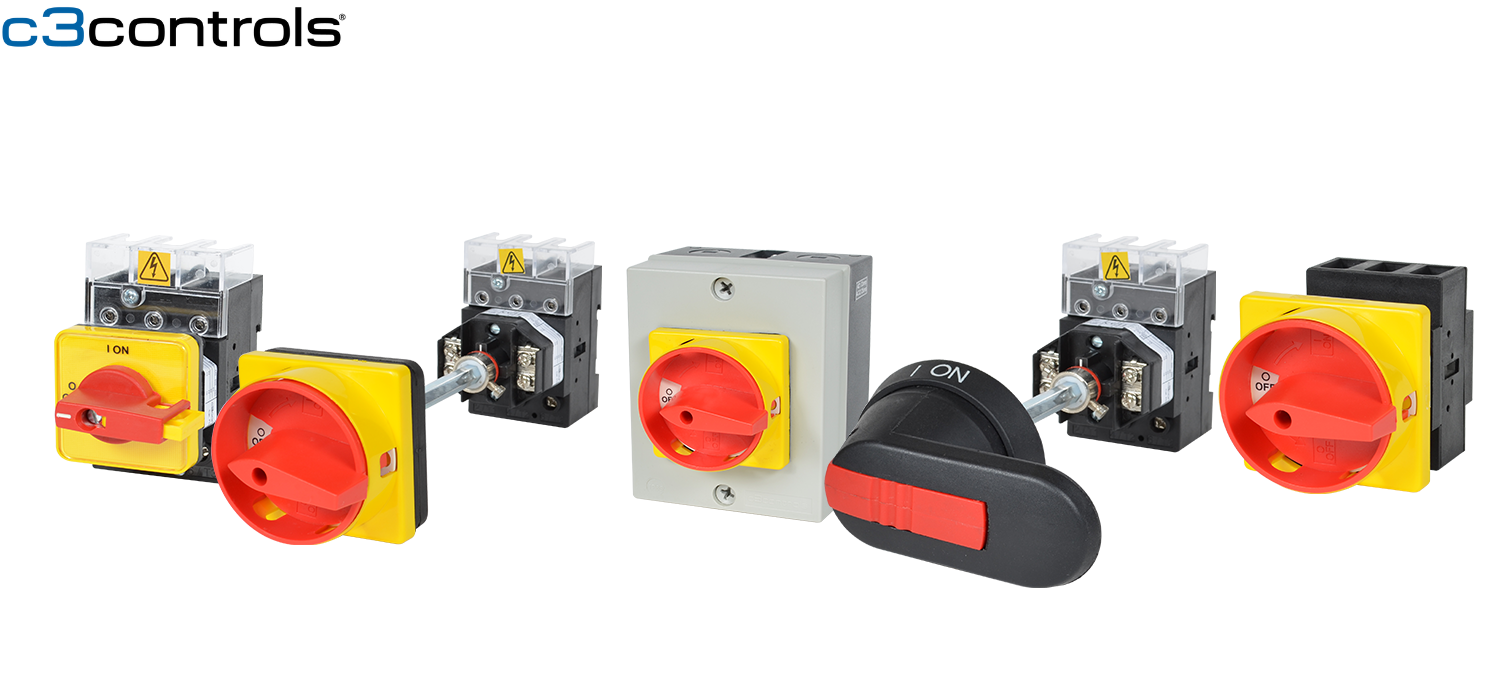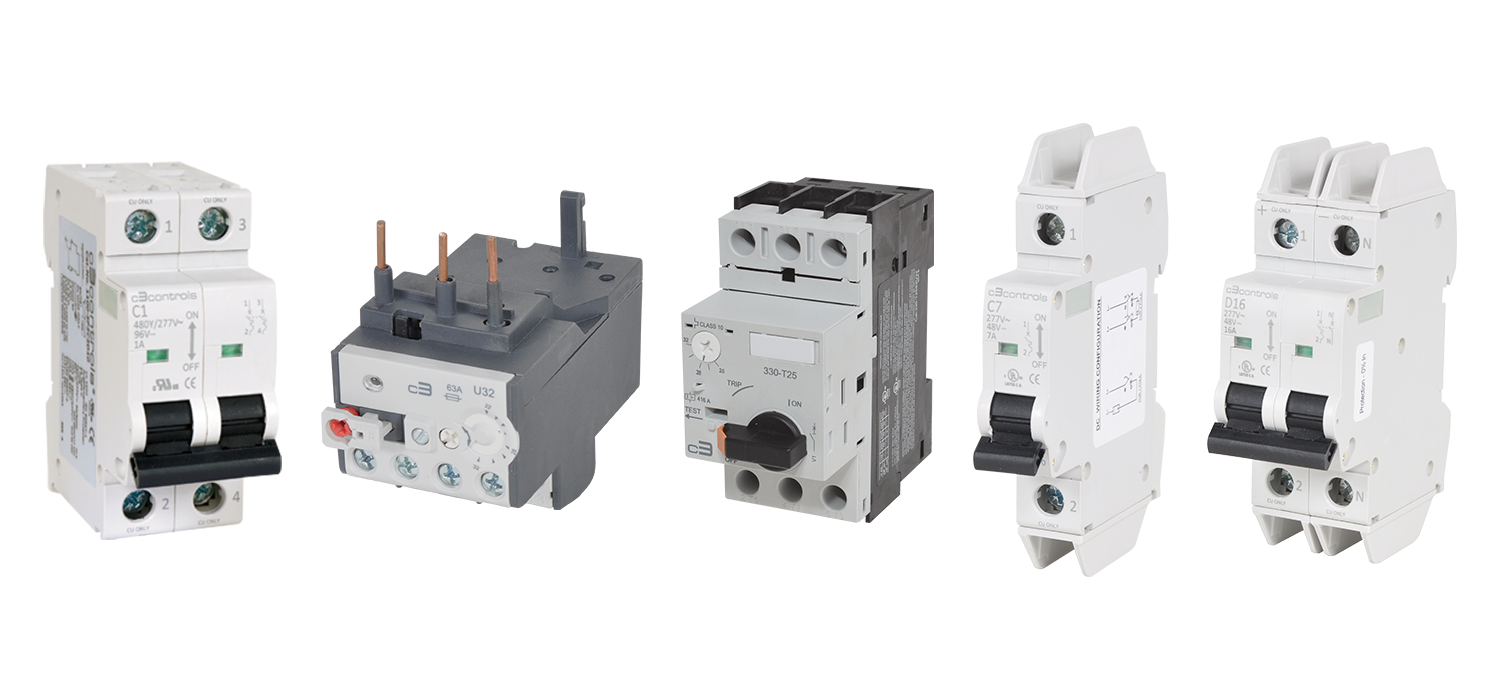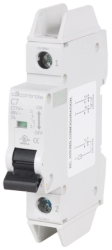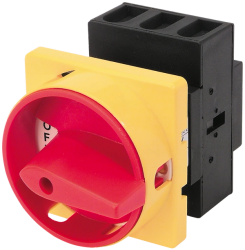Check out our full line of miniature branch circuit breakers and supplementary protectors in a wide range of pole sizes, amperage ranges, and trip curves.
Introduction
Is it possible to use a circuit breaker as a switch interchangeably, or are they separate entities?
Circuit breakers and switches are not new technologies; in fact, Thomas Edison first developed the idea for a circuit breaker in 1879.
These items are often taken for granted as they work behind the scenes, and yet they are crucial for safety in homes and in industry.
For industrial purposes, both the switch and the circuit breaker need to be able to handle a higher capacity of electricity than a residential one would.
But what are the differences between a switch and a circuit breaker?
A Disconnect Switch

An electrical switch serves the purpose of controlling the flow of electrical current to a circuit. It can be used to both remove the flow of the current or to initiate it. There are many types of switches. Relays and contactors are two other types that are commonly used in electrical controls.
A disconnect switch performs the task of manually cutting or reconnecting power from an electrical supply by creating or closing an air insulation gap between two conduction points.
They’re known as binary devices, which essentially means it has two states, open (O) and closed (|).
These symbols are international standards established by IEC.
What are the Basic Components of a Disconnect Switch?
A disconnect switch is an electrical device used to de-energize circuits or power supplied to an electrical machine during maintenance. Here are some basic components of a disconnect switch:
- Enclosure: A disconnect switch is normally installed with an enclosure that helps protect it from factors such as dust, moisture, and physical damage. The enclosure could be rated for use outdoors or indoors and made of metal, plastic, or composite materials.
- Actuator: This is the part of the switch that the operator uses to turn the switch on or off. Depending on the switch design, this might take the form of a lever, rotary handle, or pushbutton.
- Auxiliary Contacts: Additional contacts which are used in signaling or interlocking schemes, to perform a limit switch function, or to provide additional contact poles beyond the number of poles in the switch.
- Interlocking Mechanisms: A small number of disconnect switches will include interlocking mechanisms to remove the possibility of a switch being operated under unhealthy conditions. For instance, it may lock the switch from opening up at some instances until a locked-out dangerous situation has passed.
- Ground Provisions: Sometimes the disconnect switches are equipped with parts that could ground them. This type of grounding will protect you during any repair maintenance or when the electrical system has a problem.

IEC 60417-5007, (line), the power-on symbol indicates the equipment is in a fully powered state.

IEC 60417-5008, (circle), the power-off symbol indicates that the power has been disconnected from the device.
What is a Circuit?
A circuit is a closed loop that allows electric current to flow through it, facilitating the operation of electrical devices. It consists of various components, including conductors, switches, and loads, that work together to form a complete pathway. The basic principle behind a circuit is that electricity travels from a power source, through the conductors, to the load, and back again, creating a continuous loop. This flow of electricity is essential for powering everything from household appliances to complex industrial machinery.
In practical terms, circuits can be divided into two main categories: series and parallel circuits. In a series circuit, all components are connected end-to-end, meaning that the current flows through each component sequentially. This arrangement has the disadvantage that if one component fails, the entire circuit is disrupted. Conversely, a parallel circuit has multiple paths for current to flow, which means that if one path is broken, the others can still function. Understanding these two types of circuits is crucial for troubleshooting electrical issues and for making informed decisions about electrical installations.
Each circuit is designed to meet specific electrical requirements, including voltage and current ratings, which determine how much electricity can safely flow through the circuit. The design and implementation of circuits are governed by electrical codes and standards to ensure safety and functionality. For instance, residential circuits typically operate at 120 volts, while larger appliances may require a 240-volt supply. Properly designed circuits help prevent issues like overheating and electrical fires, making it essential for homeowners and businesses to understand their circuits and how they function.
How Does a Circuit Breaker Work?
A circuit breaker is an automatic electrical switch designed to protect circuits from damage caused by overloads or short circuits. It interrupts the flow of current when it detects an abnormal condition. Here's how it works:
- Sensing Abnormal Conditions: The breaker continuously monitors the current flowing through the circuit. If the current exceeds the breaker's rated capacity, it detects an overload. In the case of a short circuit, the rapid surge in current is identified almost instantly.
- Tripping Mechanism: The breaker contains either a thermal element, an electromagnetic element, or both:
- Thermal Element: A bimetallic strip bends when heated by excess current, causing the breaker to trip.
- Electromagnetic Element: A magnetic coil produces a magnetic force when current spikes. If the force exceeds a threshold, it triggers the trip mechanism.
3. Interrupting Current: Once tripped, internal contacts in the breaker separate, breaking the circuit and halting the current flow. This prevents overheating, equipment damage, and potential fire hazards.
4. Resettable Protection: Unlike fuses, circuit breakers can be reset manually or automatically after the fault is resolved.
A Circuit Breaker

A circuit breaker is a safety device to prevent damage to devices in a circuit, such as electric motors, and wiring when the current flowing through the electrical circuit supersedes its design limits. It does this by removing the current from a circuit when an unsafe condition arises. Unlike a switch, a circuit breaker automatically does this and shuts off the power immediately, or darn close to immediately. In this way it works as an automatic service protection device.
A switch is typically used as an isolator, turning power on and off to a particular device. A circuit breaker, on the other hand, can be used to protect a circuit that contains many switches or devices. An exception to this is a disconnect switch, which is used to connect or disconnect power to an entire control panel, or machine.
Simply put, a switch is designed to switch power on and off, a circuit breaker “breaks” the circuit in an overload or fault condition. Switches switch and breakers break. These differences are crucial to understanding their safety and practicality.
What are the Basic Components of a Circuit Breaker?
Circuit breakers are the most vital part of any power system as they shield the entire system against overloads and faults. Knowledge about its components helps in selecting the correct breaker to ensure safety for a system. Here are the five basic components used in every circuit breaker:
- Trip Unit: This is the brain of the circuit breaker. It senses the electrical fault and sends a signal to the operating mechanism for disconnection of the circuit. Without a trip unit, the breaker cannot perform its function.
- Operating Mechanism: The opening or closing of the breaker is done electrically by the operating mechanism. It acts with the signals created from the trip unit almost immediately. Through this, the operating mechanism ensures that the breaker can do its function of protecting the circuit by disconnecting the faults.
- Molded Frame: The molded frame encloses all other parts, adds strength, and provides insulation. It is the outer covering that defends the inner parts against environmental factors and physical damage.
- Arc Chutes: because it helps prevent excessive heat and energy that can be caused by a short circuit. Located near the contacts, arc chutes extinguish electric arcs, preventing any damage to the breaker and ensuring efficient operation.
- Contacts: There are three types of contacts in a circuit breaker: arcing, auxiliary, and main. Each performs a specific function to allow smooth conduction and safe interruption of the circuit when required. The contacts facilitate both the make and break operations, which are essential features in a circuit breaker.
By understanding these basic elements, it becomes clearer how circuit breakers work to ensure electrical safety and reliability.
What are the Categories of Circuit Breakers?
Generally, there are four main categories of circuit breakers with different purposes and applications. Here's a closer look:
- Molded Case Circuit Breakers (MCCB): Molded Case Circuit Breakers are robust, maintainable devices that can be used in residential to industrial sectors. Typically, they have a current rating range from 15 to 1200 amps. MCCBs can be found in one, two, or three-pole arrangements. Known for their reliability, these breakers are frequently utilized in lighted panelboards.
Key Features:
- Current Rating: 15-1200A
- Pole Configurations: Single, two-pole, three-pole
- Applications: Residential, industrial
- Insulated Case Circuit Breakers: These are made to be more rugged and are applied with frame sizes of 800 to 4000 amperes. These breakers are more often used in commercial installations and light industries like office buildings, schools, and shopping centers. While these circuit breakers have limited maintainability, they come with a rugged design and are used with larger mains for intensive purposes.
Key Features:
- Frame Sizes: 800-4000A
- Applications: Commercial, light industrial
- Durability: Rugged design, limited maintainability
- Air Power Circuit Breakers: Often integrated into switchgear systems and ideal for heavy industrial applications. These are the most reliable breakers and are field-serviceable, with frame sizes ranging from 250 to 6000 amps. They are used in settings that require high levels of reliability, such as hospitals and data centers. Moreover, they are designed to handle heavy switching and have replaceable contacts.
Key Features
- Frame Sizes: 250-6000A
- Applications: Heavy industrial, hospitals, data centers
- Serviceability: Field-serviceable, replaceable contacts
- Miniature Circuit Breakers (MCB): Hugo Stotz was the inventor of the first modern miniature circuit breaker, listed under German patent 458392. Miniature Circuit Breakers (MCBs) are used in low-energy settings such as home wiring, offices, and small electronic devices. They operate on two mechanisms—one that reacts to overheating and the other that responds quickly to short circuits.
Key Features:
- Applications: Residential, offices, small electronics
- Protection Mechanisms: Delayed thermal (overload protection), magnetic (short circuit protection)
Each type of circuit breaker is designed to meet specific needs, ensuring safety and efficiency across various electrical systems. The categories above help in choosing the right breaker for the right application.
Common Reasons Why Circuit Breakers Trip
- Overloaded Circuits:
- When too many devices draw power from the same circuit, the current exceeds its capacity, causing the breaker to trip.
- Example: Running a microwave, toaster, and refrigerator on the same circuit simultaneously.
- Short Circuits:
- It occurs when a live wire touches a neutral or ground wire, creating a sudden, high-current flow. This is usually due to damaged wiring or faulty devices.
- Ground Faults:
- It is similar to a short circuit but occurs when a live wire touches a grounded part of a device or the earth. Common in wet or damp areas.
- Arc Faults:
- High-energy electrical discharges are caused by loose or damaged wiring. These arcs can generate heat and ignite fires.
- Faulty Circuit Breaker:
- Breakers can degrade over time or malfunction, causing them to trip unnecessarily or fail to trip when needed.
The BIG Difference
When it’s all said and done, a big reason NOT to use a circuit breaker as a disconnect switch is a question of endurance. Disconnect switches are designed for a high number of operations, how many times the disconnect switch is turned on and off . Circuit breakers are typically not rated for nearly the same amount of operations.
A miniature circuit breaker is a deceiving simple device. It is a much more complicated device, with more parts, than a switch. Cycling a breaker on and off numerous times will result in its eventual failure.


However...
Circuit breakers can be rated for switching duty for lighting circuits. Circuit breakers applied in 120V or 277V fluorescent lighting circuits must be marked SWD or HID. SWD stands for Switching Duty. HID signifies rated for High Intensity Discharge lighting. The UL489 Standard for MCBs states that an SWD circuit breaker can be rated up to 20A, no more. HID breakers are rated up to 50A.
Which Will It Be Then?
The question still begs, even though it’s obvious by now, can you use a circuit breaker like a switch in an industrial control panel? It’s quite evident that though they share a similar function on a basic level, they are two separate entities.
Circuit breakers may work as effective as safe switches, but they are not switches. They are not interchangeable. Therefore, using a circuit breaker as a switch is not recommended.
Can I Use A Switch In Place Of A Circuit Breaker?
No. Don’t ever do this. A switch cannot detect and interrupt an overload or fault condition. This can lead to an unsafe or potentially dangerous condition, putting equipment and more importantly, people at risk.
If you need more advice on how circuit breakers and switches function, and how to use them safely, don’t hesitate to contact us.
FAQs related to circuit breakers
1. How do I choose the right circuit breaker for my needs?
To choose the right circuit breaker, it’s essential to identify the voltage and current requirements of your system. The breaker’s interrupting capacity should match the potential fault current of the circuit. Additionally, the type of breaker needed depends on the application, such as standard breakers for general use, GFCIs for wet areas, or AFCIs for preventing arc faults in living spaces.
2. What are the signs that my circuit breaker needs maintenance or replacement?
Signs that a circuit breaker may need attention include frequent or unexplained tripping, a breaker that feels hot to the touch, burn marks or a burning smell near the panel, and visible physical damage like cracks or wear on the breaker housing. Addressing these issues promptly ensures safety and prevents potential electrical hazards.
3. Can circuit breakers protect against electrical fires?
Circuit breakers do protect against electrical fires by interrupting the current in cases of overloads, short circuits, and ground faults. Advanced models like Arc Fault Circuit Interrupters (AFCIs) are specifically designed to detect and address arc faults, a common cause of electrical fires, offering an extra layer of safety.
4. What is the difference between a circuit breaker and a surge protector?
While both devices protect electrical systems, they serve different purposes. A circuit breaker safeguards against overcurrent and short circuits by cutting off the electrical flow when necessary. In contrast, a surge protector defends devices from voltage spikes, such as those caused by lightning or power surges. Both are crucial but operate in distinct ways to ensure safety and equipment longevity.
5. Are there any safety tips for using circuit breakers?
To ensure safety when using circuit breakers, keep the panel accessible and properly labeled for quick identification. Avoid overloading circuits by evenly distributing electrical loads. Never attempt to bypass or forcibly hold a tripped breaker in place, as this could lead to severe hazards. Regular inspections are vital to check for wiring issues or aging breakers. Additionally, select the correct breaker type for specific areas, such as AFCIs for bedrooms and GFCIs for wet locations, to enhance protection.
----------------------------------------
Disclaimer:
The content provided is intended solely for general information purposes and is provided with the understanding that the authors and publishers are not herein engaged in rendering engineering or other professional advice or services. The practice of engineering is driven by site-specific circumstances unique to each project.
Consequently, any use of this information should be done only in consultation with a qualified and licensed professional who can take into account all relevant factors and desired outcomes. The information was posted with reasonable care and attention. However, it is possible that some information is incomplete, incorrect, or inapplicable to particular circumstances or conditions. We do not accept liability for direct or indirect losses resulting from using, relying or acting upon information in this article.
ISO 9001:2015
Certified
17+ Million Product
Configurations
Lifetime
Warranty
Guaranteed
Same-Day Shipping
Advantage Pricing
Save Up To 40%
c3controls Headquarters, USA
664 State Avenue
Beaver, PA 15009
